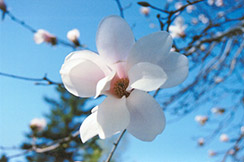It's all about ...
plants

Borealis Magnolia
Magnolia kobus var. borealis
Height: 40 feet
Spread: 40 feet
Sunlight:
![]()
![]()
Hardiness Zone: 4a
Description:
A stunning accent tree for general landscape use, featuring large snow-white flowers in spring, neat foliage turning yellow in fall, and picturesque habit of growth; the most cold hardy magnoila available; may take a number of years to flower
Ornamental Features
Borealis Magnolia is smothered in stunning fragrant white star-shaped flowers at the ends of the branches in early spring before the leaves. It has dark green deciduous foliage which emerges coppery-bronze in spring. The large pointy leaves turn yellow in fall. The fruits are showy pink pods displayed from early to mid fall.
Landscape Attributes
Borealis Magnolia is a deciduous tree with a distinctive and refined pyramidal form. Its relatively coarse texture can be used to stand it apart from other landscape plants with finer foliage.
This is a relatively low maintenance tree, and should only be pruned after flowering to avoid removing any of the current season's flowers. Deer don't particularly care for this plant and will usually leave it alone in favor of tastier treats. It has no significant negative characteristics.
Borealis Magnolia is recommended for the following landscape applications;
- Accent
- Shade
Planting & Growing
Borealis Magnolia will grow to be about 40 feet tall at maturity, with a spread of 40 feet. It has a low canopy with a typical clearance of 5 feet from the ground, and should not be planted underneath power lines. It grows at a fast rate, and under ideal conditions can be expected to live for 80 years or more.
This tree does best in full sun to partial shade. It requires an evenly moist well-drained soil for optimal growth, but will die in standing water. It is not particular as to soil type, but has a definite preference for acidic soils. It is quite intolerant of urban pollution, therefore inner city or urban streetside plantings are best avoided. Consider applying a thick mulch around the root zone in winter to protect it in exposed locations or colder microclimates. This species is not originally from North America.
This plant is not reliably hardy in our region, and certain restrictions may apply; contact the store for more information.

